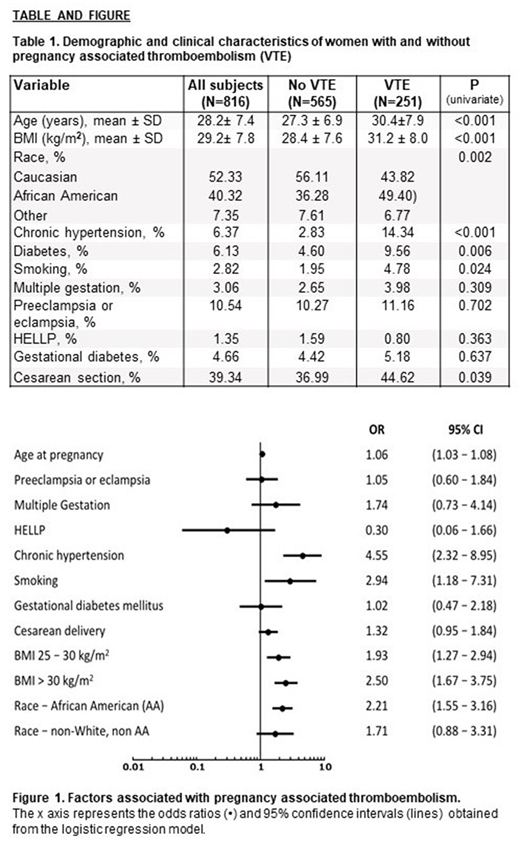Abstract
INTRODUCTION: Pregnancy is a risk factor for venous thromboembolism (VTE) and VTE affects 1 in 500 to 1 in 2000 pregnancies. Up to 30-50% of women with pregnancy-associated VTE may have an inherited thrombophilia but this does not completely explain the thrombosis risk. Clinical risk factors for VTE including multiple births, inflammatory bowel disease, sickle cell disease, diabetes, increased maternal age, stillbirth, and smoking have been identified in relatively small cohorts. We conducted this large case-control study to identify patient and pregnancy-associated risk factors for VTE during pregnancy or within 6 weeks post-partum.
METHODS: The study population was drawn from the Vanderbilt University Medical Center bio-repository (BioVU) that includes de-identified clinical data and DNA samples (from 2007 to 2017). We used a phenotyping algorithm using ICD9 and ICD10 diagnosis codes for pregnancy and venous thromboembolism, as well as procedure codes for pregnancy-related procedures to identify women with VTE during pregnancy or within 6 weeks following delivery (cases), and age matched pregnant women without any history of VTE (controls). Subsequently, manual review of all patients identified by the phenotyping algorithm was performed to confirm case status. Initially, 2 controls per case we identified; however 21 (of 272) cases were reclassified as controls on manual review. Data regarding demographic variables, body mass index (BMI), smoking and comorbidities potentially impacting VTE risk (diabetes, gestational diabetes, multiple pregnancy, eclampsia, preclampsia, HELLP syndrome) was extracted using diagnosis codes. Multivariable logistic regression was used to identify associations with pregnancy-associated VTE.
RESULTS: The study population comprised 816 individuals including 251 women with pregnancy-associated VTE and 565 controls; 52.3% were Caucasian, 40.3% were African American, and 7.4% comprised other races. Mean age at index pregnancy was 28.2 ± 7.4 years. A pre-pregnancy diagnosis of chronic hypertension affected 6.37%, diabetes mellitus affected 6.13%, and 2.82% reported smoking during or within 6 weeks of pregnancy (Table 1). Multiple gestation, preeclampsia/eclampsia, gestational diabetes, and HELLP syndrome affected 3.06%, 10.54%, 4.66%, and 1.35% of pregnancies, respectively. Thrombophilia was diagnosed in 20 women with pregnancy-associated VTE (8 antiphospholipid syndrome [APS], 4 protein S deficiency, 1 protein C deficiency, 4 factor V Leiden [FVL] heterozygotes and 1 each with FVL with APS and FVL with protein C deficiency). However, thrombophilia evaluation was not performed consistently and thus was not included in the final multivariable analysis.
In a multivariable logistic regression model (Figure 1), age at pregnancy (odds ratio [OR] 1.06 [95% CI 1.03-1.08], P<0.001), smoking (OR 2.94 [95% CI 1.18-7.31], P=0.020), chronic hypertension (OR 4.55 [95% CI 2.32-8.95], P<0.001), BMI (OR 1.93 [95% CI 1.27-2.94], P = 0.002 for BMI 25-30 kg/m2; OR 2.50 [95% CI 1.67-3.75], P<0.001 for BMI >35 with a BMI of 18.5-25 as the reference category), and African American race (OR 2.21 [95% CI 1.55-3.16], P<0.001) were associated with pregnancy-associated VTE. Preeclampsia/eclampsia (OR 1.05 [0.60-1.84], P=0.856), multiple gestation (OR 1.74 [95% CI 0.73-4.14], P=0.211), HELLP (OR 0.30 [95% CI 0.06-1.66], P=0.169), gestational diabetes (OR 1.02 [95% CI 0.47-2.18], P=0.968), and delivery by cesarean section (OR 1.32 [95% CI 0.95-1.84], P=0.099) were not significant risk factors for pregnancy-associated VTE.
CONCLUSION: This large case-control study demonstrates that modifiable factors such as maternal obesity, smoking and chronic hypertension are important risk factors for pregnancy-associated VTE along with increasing maternal age and African American race. Addressing modifiable risk factors prior to conception may reduce the risk of pregnancy-associated VTE.
No relevant conflicts of interest to declare.
Author notes
Asterisk with author names denotes non-ASH members.


This feature is available to Subscribers Only
Sign In or Create an Account Close Modal